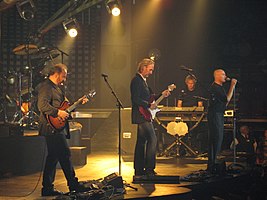Year 24 Group (24年組, NijÅ«yo-nen Gumi) refers to one of two female manga artist groups which are considered to have revolutionized shÅjo manga (girls' comics). Their works often examine "radical and philosophical issues", including sexuality and gender issues, and many of their works are now considered "classics" of shÅjo manga. Many of those in the first group, Fabulous Year 24 Group (花ã®24年組, Hana no NijÅ«yo-nen Gumi), also known as the Forty-Niners, were born in ShÅwa 24 (1949). The exact membership is not precisely defined, but includes Yasuko Aoike, Moto Hagio, Riyoko Ikeda, Yumiko ÅŒshima, Keiko Takemiya, Toshie Kihara, Ryoko Yamagishi, Minori Kimura, Nanae Sasaya, and Mineko Yamada. A second group, known as Post Year 24 Group (ãƒã‚¹ãƒˆ24年組, Posuto NijÅ«yo-nen Gumi), includes Wakako Mizuki, Michi Tarasawa, Aiko ItÅ, Yasuko Sakata, Shio SatÅ, and Yukiko Kai.
The Year 24 Group significantly contributed to the development of subgenres in shÅjo manga, and marked the first major entry of women artists into manga. Thereafter, shÅjo manga would be drawn primarily by women artists for an audience of girls and young women. The Year 24 Group used bildungsroman genre conventions in their works. Stylistically, the Year 24 Group created new conventions in panel layout by departing from rows of rectangles that were the standard of the time and using panel shape and configuration to convey emotion, and softening or removing panel borders. At around the same time as the year 24 group were creating manga, shÅjo manga magazines began serialising on a weekly basis.
Moto Hagio and Keiko Takemiya lived in the same apartment in ÅŒizumi in Nerima, Tokyo from 1970 to 1973, in a situation similar to Osamu Tezuka's Tokiwa-so. Takemiya's friend Norie Masuyama lived nearby and was described by Moto Hagio as Takemiya's "brain staff". Masuyama was not a manga artist herself, but she introduced Takemiya to male homosexuality for women via Barazoku, which inspired Takemiya and Hagio to create shÅnen-ai works. Until that time, shÅjo manga was written mainly by male manga artists, such as Osamu Tezuka with his Princess Knight, and their attempts by female manga artists to write manga for girls were relatively new.
Comiket, the world's largest comic convention, was started by the dojinshi circle Meikyu (è¿·å®®), which began as a group for studying the works of Moto Hagio.
Works by Hagio and SatÅ were included in the shÅjo manga anthology Four ShÅjo Stories, published in North America by Viz Communications in 1996.
References



Posting Komentar